Outforia Quicktake: Key Takeaways
- Siamangs are the largest gibbons, native to the Malay Peninsula, Malaysia, Thailand, and Sumatra Island, Indonesia, and live in rainforests and monsoon forests.
- They have distinctive large, grayish-pink inflatable throat sacs used for loud vocalizations and communication.
- Siamangs are social animals with complex communication systems; they live in groups consisting of an adult pair and their offspring.
- Their diet primarily includes fruits and leaves, making them essential for plant species distribution and seed dispersal in their environment.
- Siamangs are classified as endangered due to habitat loss from deforestation and the illegal pet trade.
Siamangs are easy to spot because of their incredibly loud vocalizations. These vocalizations are accompanied by the inflation of their large, grayish-pink throat sac. This sac is unique to their species and can grow as large as a grapefruit.
There are 14 different kinds of gibbons, and the siamang is the largest. They are an agile arboreal species. They are social and have complex communication systems.
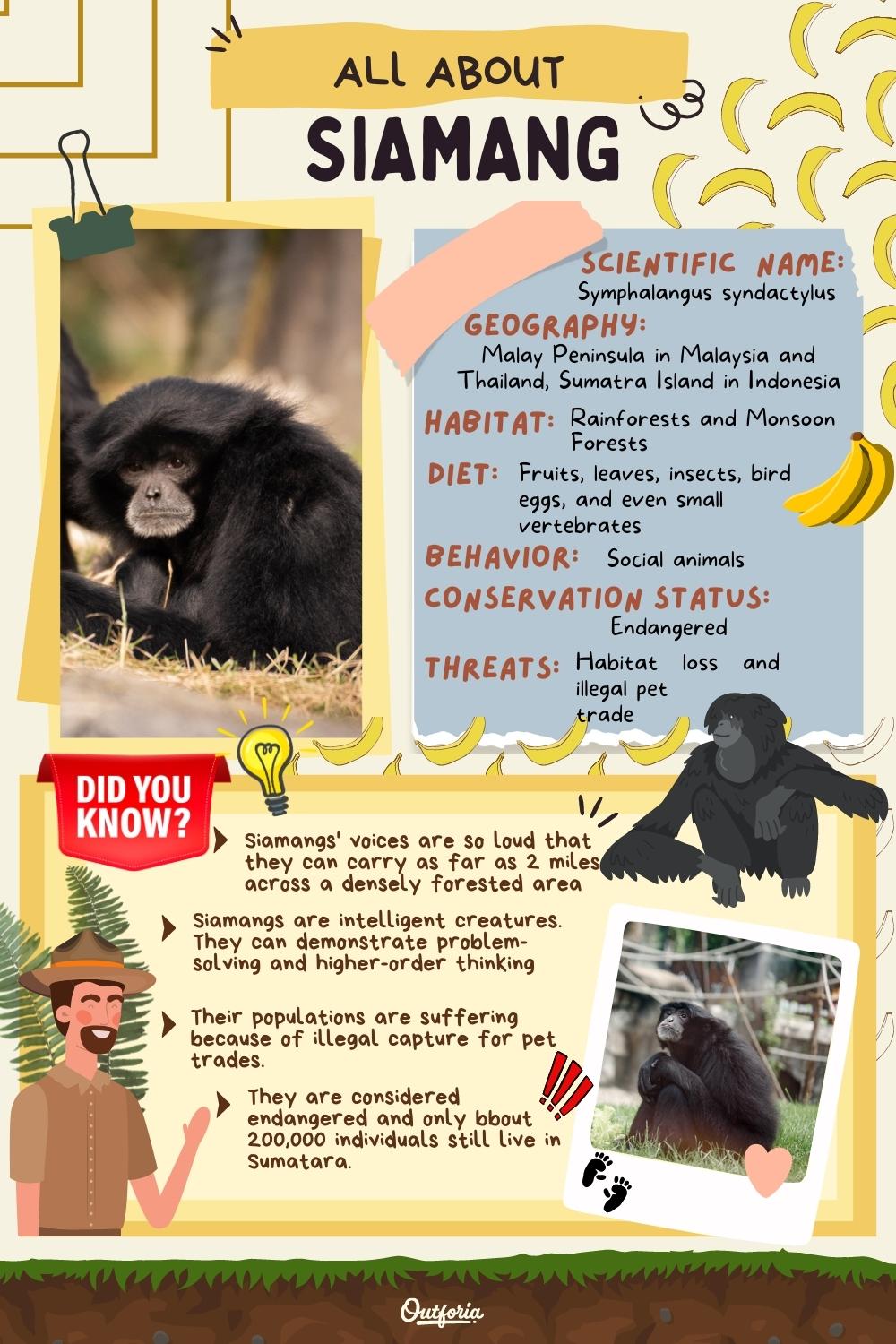
SHARE THIS IMAGE ON YOUR SITE
<a href="https://outforia.com/siamang/"><img style="width:100%;" src="https://outforia.com/wp-content/uploads/2022/08/siamang-infographic-683x1024.jpg"></a><br>SIAMANG <a href="https://outforia.com">Outforia</a>What Do We Call Them?
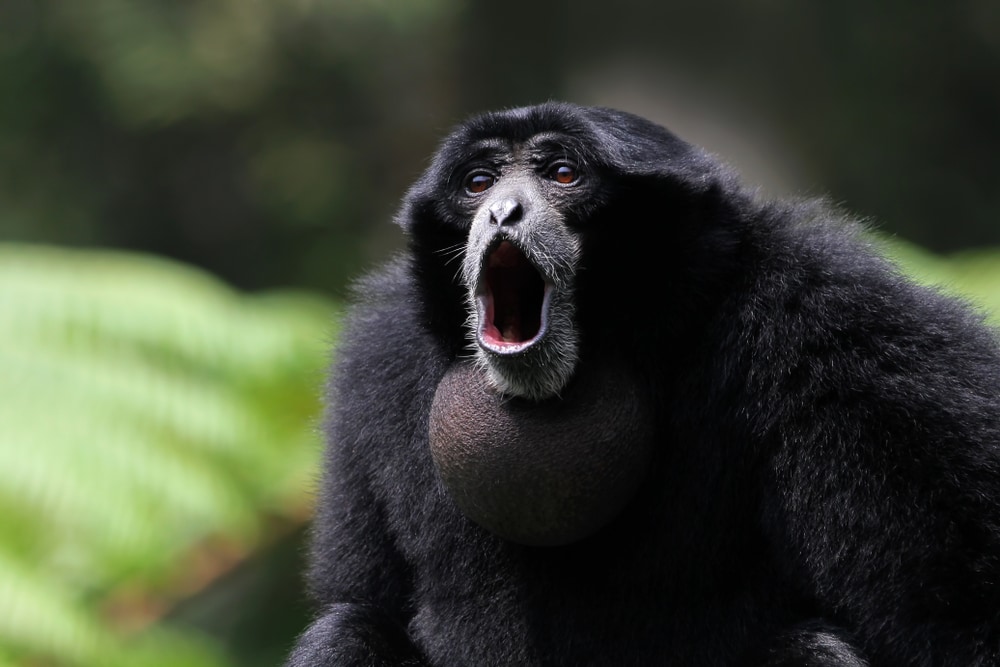
The siamang (Symphalangus syndactylus) is a lesser ape in the gibbon family.
They are also known as the “greater gibbon,” “Sumatran siamang,” and “Malaysian siamang.”
What Do They Look Like?
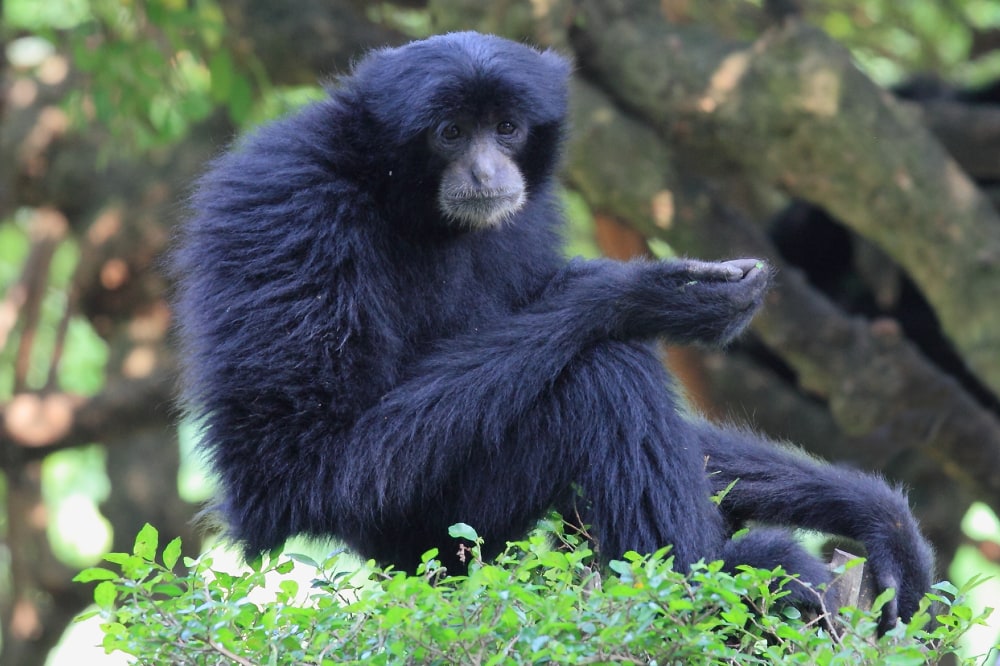
Males, females, and juveniles all have long coats of shaggy black fur. The black fur is interspersed with pale-colored hairs around the mouth and chin.
They have very long arms that may be up to 2.5 times the lengths of their body. They also have broad hands and feet with slight webbing between the second and third toes.
Their canine teeth are long and formidable, and they have opposable thumbs. Besides their opposable thumb, they have a “great” toe. It is separate from the other toes used in grabbing. This opposable toe is unique to siamangs and does not occur in other gibbons.
They are remarkable at swinging through the treetops. This is partly due to their small, slender bodies and lightweight bones.
There are 14 types of gibbons, and the siamangs are the largest kind. They average about 29-35in (74-89cm) in height and 23lbs (10kg) in weight. Their arms are incredibly long, reaching an arm span as wide as 4.9ft (1.5m).
Inflatable Throat Sac

The thing that sets these apes apart is their large throat sac. They use this throat sac to make their vocalizations louder. This provides better communication with other siamangs.
The throat sac is generally a grayish-pink color. It’s easy to spot the sacs because they inflate when the ape vocalizes. In fact, they inflate so much that the sac may become as large as a grapefruit.
Males
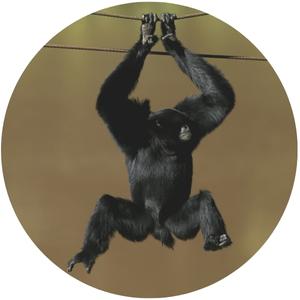
Males and females are sexually dimorphic, mainly in size. Males are typically larger than females. Otherwise, both males and females look very similar.
But the males also have long tufts of hair covering their genital region. This tuft of hair is a “genital tassel” which faces downward and looks somewhat like a tail. The genital tassel may be as long as 5.3in (13.5cm).
Females
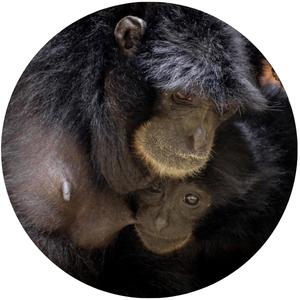
The main difference between males and females is the size. Males average about 26.6lbs (11.9kg), while females only average about 23.6lbs (10.7kg).
Infants
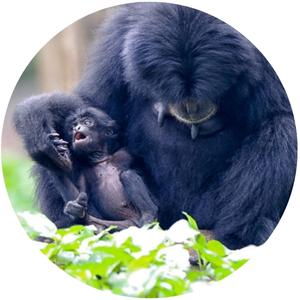
The infants are born completely hairless except for a single tuft of hair at the top of their heads.
Where Can We Find Them?
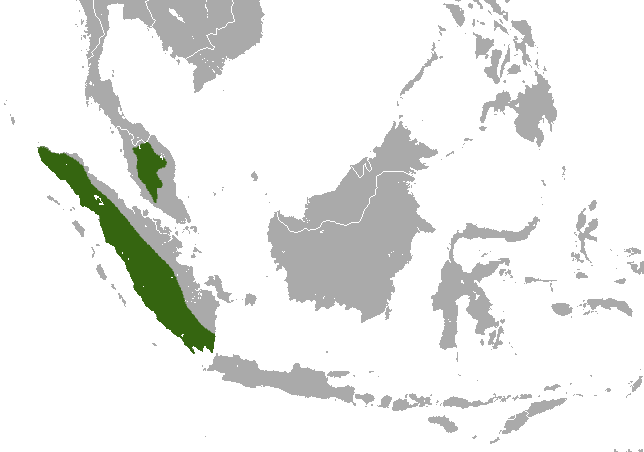
By IUCN Red List of Threatened Species, species assessors and the authors of the spatial data / CC BY-SA 3.0 / Wikimedia commons
Siamangs live across the Malay Peninsula in Malaysia and Thailand. They also live on the island of Sumatra in Indonesia.
There are two subspecies, with each subspecies living in separate locations. S. s. Syndactylus lives on the island of Sumatara, while S. s. Continents lives in the Malay Peninsula.
You may also like: All The 26 Different Types Of Apes: Pictures, Classification And Chart
Where Do They Live?
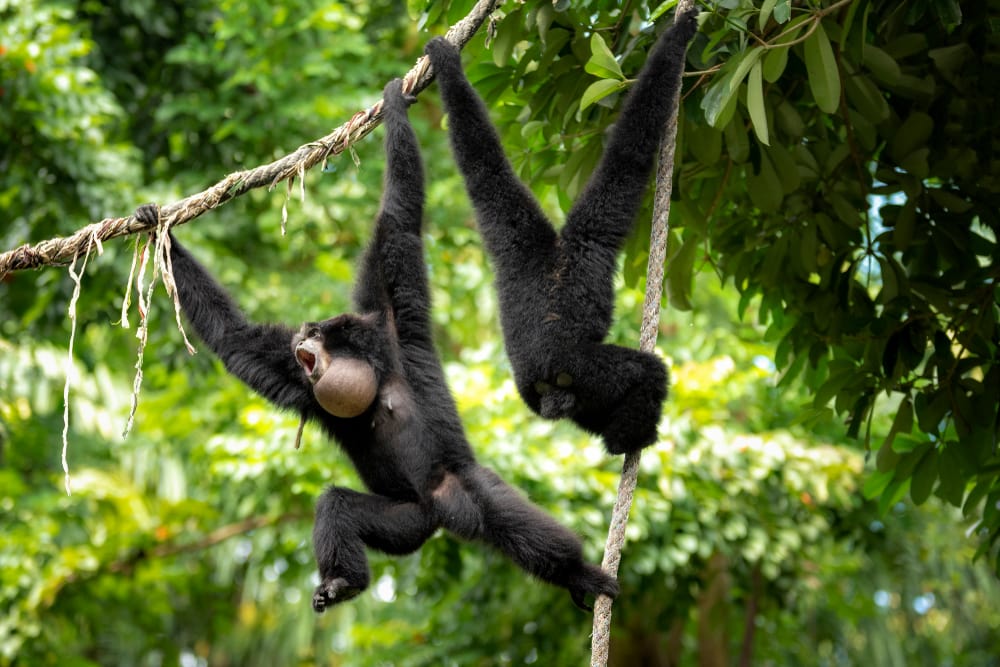
They are an arboreal species that prefers habitats of rainforests and monsoon forests. They are usually found in areas above 984.3ft (300m) above sea level but may also live in lowland forests. They are rarely seen above 4,921.3ft (1,500m).
They may also live in freshwater swamp forests, lowland forests, and submontane forests.
They prefer to live high up in the trees at heights up to 80-100ft (25-30m).
Their home areas are relatively small. They will only inhabit an area of about 60 acres (0.24 sq. km).
Unlike the great apes, they do not create nests. Instead, they sleep in the fork of a tree, sitting upright. They usually sleep alone but may also sleep huddled in small groups.
What Do They Eat?
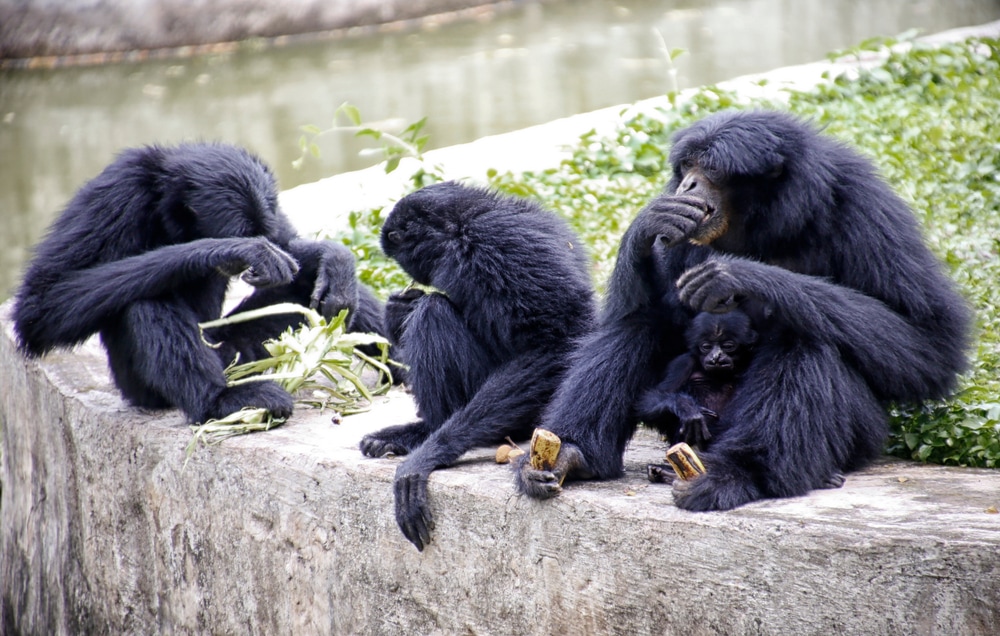
Siamangs are omnivores who feast mostly on a diet of fruit and new leaves. Unlike other gibbons, their diet consists of a larger amount of leaves. About 44% of their diet consists of fruit, while 45% consists of leaves.
Of the fruits, figs seem to be their favorite, making up about 37% of their total diet. They also seem to prefer young leaves over mature leaves. They only eat a very small amount of mature leaves.
The other 11% of their diet consists of insects, bird eggs, and even small vertebrates.
While eating, siamangs prefer to suspend themselves from a tree with one arm. They will use their other arm to eat their meal.
You may also like: 25 Remarkable Types Of Monkeys (Names, Photos And More)
How Do They Behave?
Movement
When these apes swing from trees, we describe the movement like a pendulum. They swing slowly, grabbing a single branch. Then, they will release that branch before grabbing onto the next one. This method of swinging through the trees is called “brachiating.”
In this way, they fling their body through the air to get from one branch to the next. They are so adept at this movement that they can fly through the air as much as 25-32ft (8-10m) in a single swing.
When they are on the ground, they usually choose to be bipedal, moving on their two legs.
They spend most of their time in the treetops and may travel up to 1 mile (1.6km) a day. When they’re on the ground, they only travel by dry land. Siamangs cannot swim and will avoid water.
Daily Routine
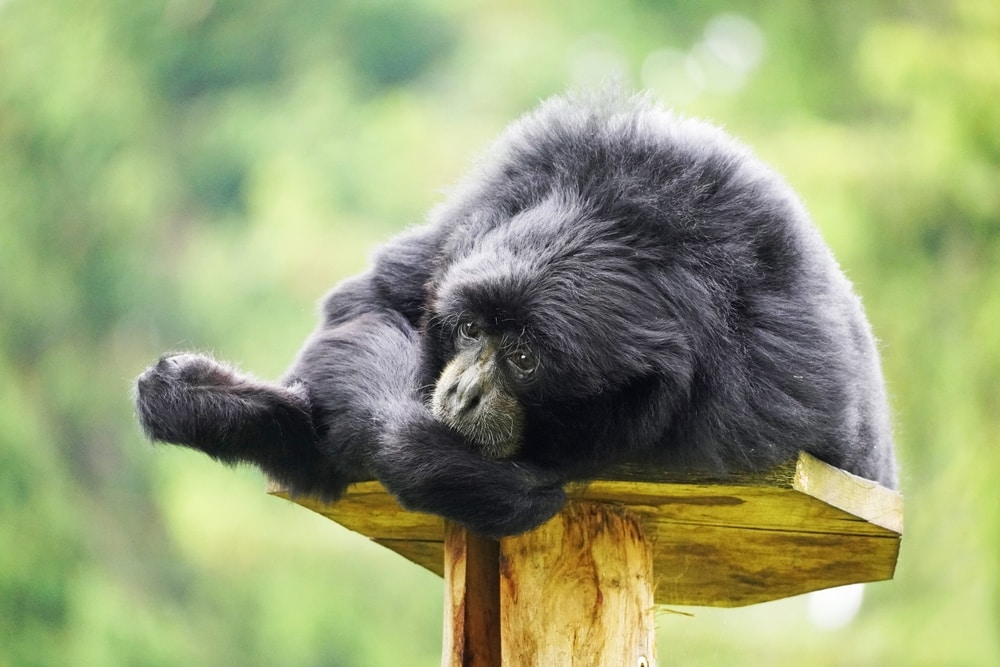
Siamangs prefer to have a routine in their daily life. They wake up with the sun and perform their morning vocalizations. The adult female usually starts the morning vocalizations. Morning calls are territorial and warn other siamang groups. Sometimes, morning vocalizations can last for up to 30 minutes.
Then, they go in search of food. On average, it takes a single siamang about 5 hours to find enough food to fill their belly. Most of the feeding occurs early in the morning and gradually drops off throughout the rest of the day.
They are active for about 8-10 hours a day before finding a place to settle down and sleep. They usually go to sleep around dusk, choosing to sleep in the same tree as they do every night.
Social Structure
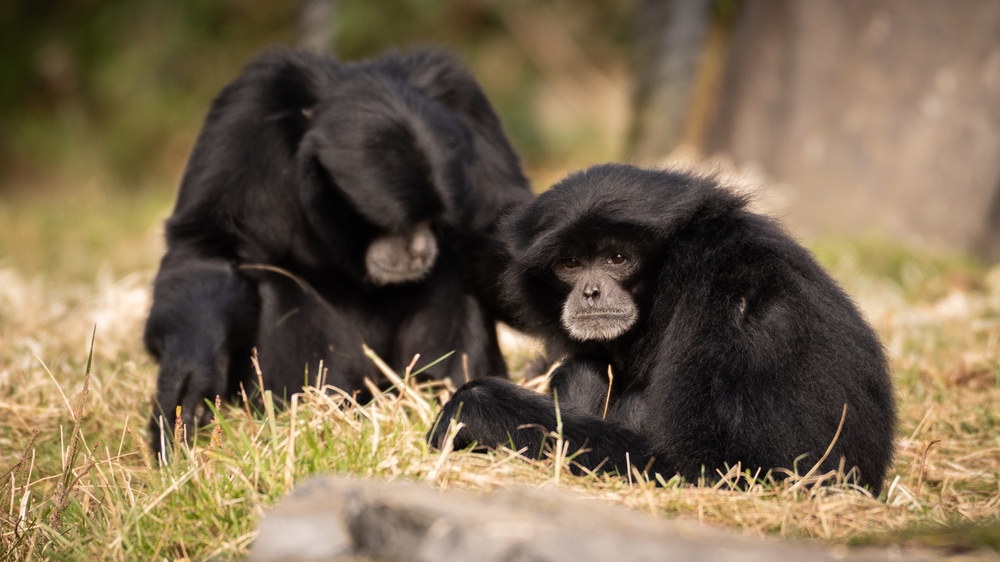
Siamangs are social animals who live in groups. The group usually consists of an adult pair along with their offspring. Unlike most primates, the breeding pair usually stays together for life. There are usually two to three offspring in the group, separated in age by two to three years.
These family groups have a lot of contact throughout the day. They perform daily activities together, like foraging for food.
It is rare for siamangs to move further than 30ft (10m) away from each other during activities. It’s incredibly rare for them to move more than 100ft (30m) away from each other at any point during the day.
They will also groom each other, although this is a display of dominance. The more dominant group members receive more grooming than they provide to others. Grooming takes about 15 minutes a day on average.
Still, the adult male will spend time grooming the females and subadults of the group. During the breeding season, he will focus more heavily on females.
They Are Territorial
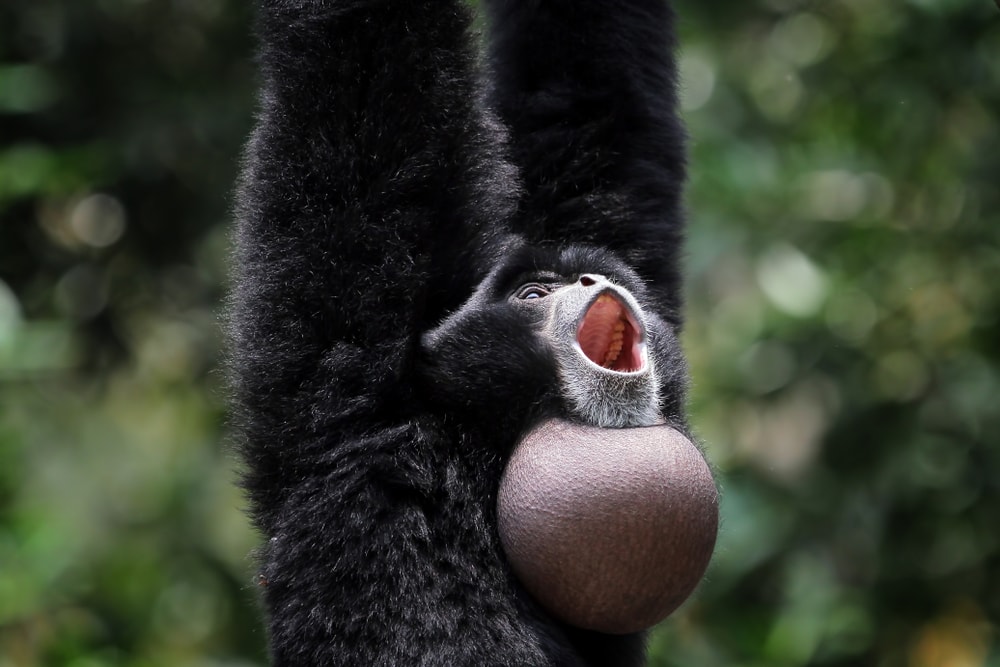
Siamangs are very territorial, which is why their throat sac is so important. They defend their territory every day by going through a set of singing rituals.
They live in groups and defend most of their territory in groups. They protect about 60% of their home range as a group effort.
Their loud, far-reaching vocalizations help to prevent confrontations between other groups of siamangs. Their calls are loud, so it’s harder for them to distinguish boundaries between groups. Their boundaries tend to be larger, preventing most confrontations.
When a boundary dispute does occur, the siamangs will chase each other through the trees. As they chase the perceived intruder, they will also bite and slap at them.
Living Around Other Primates
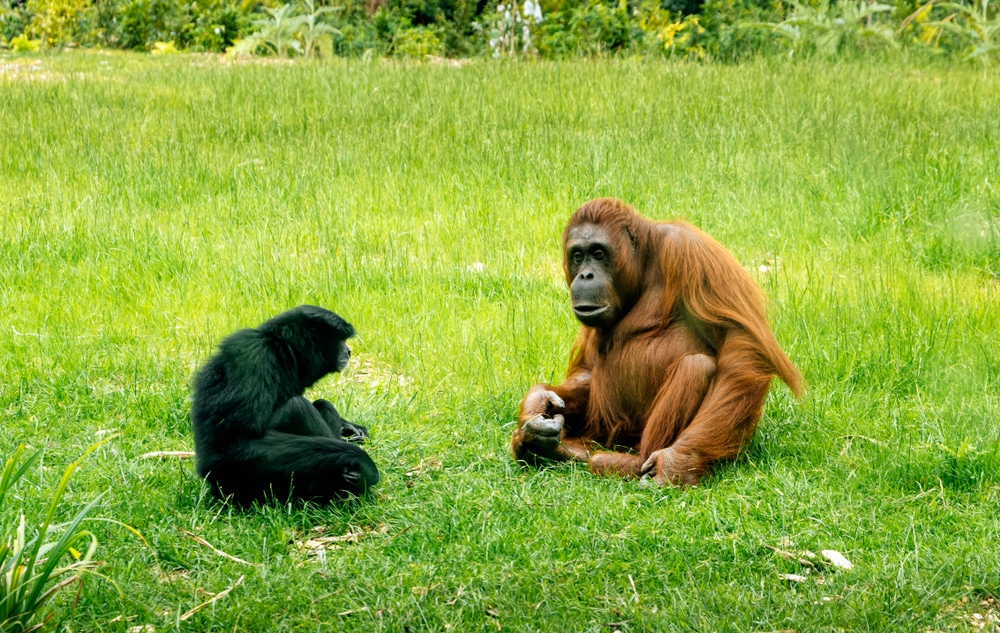
Siamangs live in the same area as many other primates. Some species include the slow loris, long-tailed macaque, pigtail macaque, Thomas’s langurs, and lar gibbon.
Communication
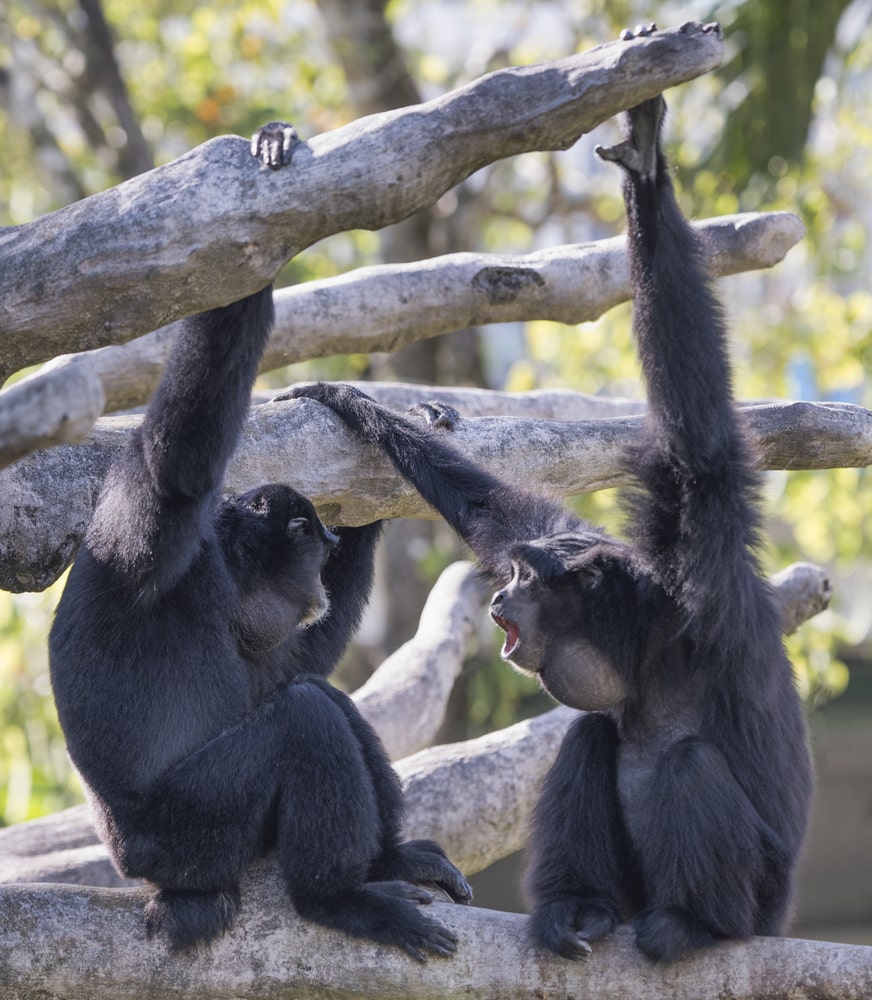
Both males and females have a large, inflating throat sac for vocalization. In fact, males and females will call together.
When they vocalize, the calls repeat one after the other. The calls start off slowly, gradually increasing in speed.
When they vocalize, siamangs will often perform acrobatics as well.
They can produce two different sounds using their throat sac. The first is deep and booming. This vocalization is louder and can reach farther across the forest. They create this sound by singing into the sac with their mouth closed.
The second vocalization produces a “wow” sound. They create this sound by singing into their throat sacs with their mouth open.
Besides using their sac, they can also produce a series of barks.
The calls that siamangs produce using their air sacs are incredibly loud. They are so loud that you can hear them from up to 2 miles (3.2km) away through a dense forest.
Siamang vocalizations are usually used for claiming and defending territory. They begin their calls with low, booming vocalizations. This is followed by a high-pitched yell. They finish out the call with raucous, high-pitched laughter.
But bonded pairs will also sing duets with one another. This experience is so unique that they will create a song of their own, special to that specific pair.
How Do They Reproduce?
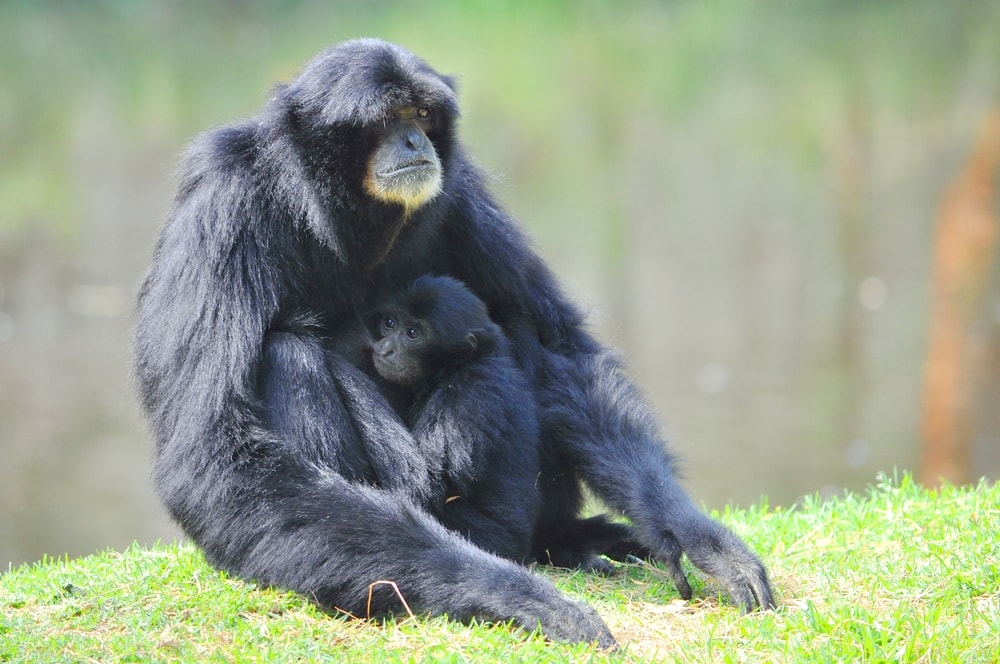
When a female becomes pregnant, the gestation period lasts about seven and a half months. She will give birth to a single offspring about once every two to three years. It is rare for a female to give birth more than ten times over her lifetime.
When they are born, infants weigh an average of just 6oz (170g).
The infants will remain with their mothers constantly for the first three to four months of life. They do so by clinging to their mother’s bellies.
Unlike other gibbons, male siamangs provide care to their infant offspring. In fact, they provide most of the infant’s care during its second year of life. Two years of age is about the time when the offspring weans and the father begins to carry them.
The males help care for their offspring throughout their life. At other periods of the infant’s life, the father will act as a protector. They may occasionally groom and play with their offspring, too.
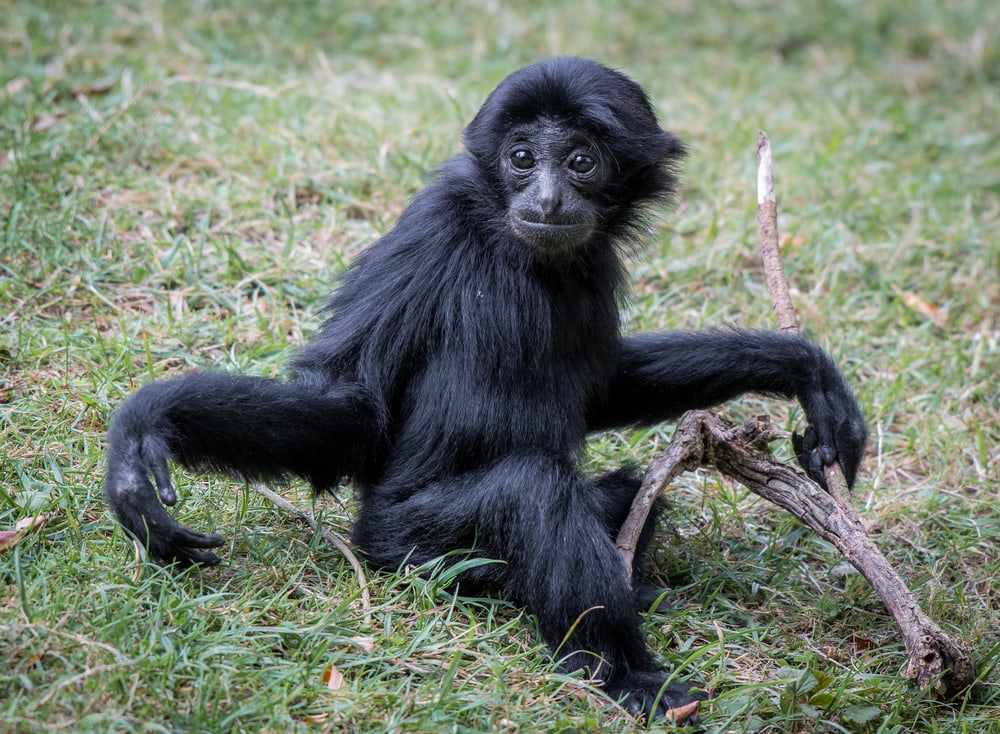
They wean at about two years of age but will not become sexually mature until about six or seven years old. They won’t reach full maturity until about eight or nine years of age.
They stay with their family group after weaning. They won’t leave until they’ve reached sexual maturity. After that point, they leave their family group to create their own.
Shortly after leaving, the young siamang becomes independent from its parents. They also begin to vocalize separately. This is the case for both males and females.
Sometimes, a young siamang may take several years to find a mate. This is because they’re very picky about the mate they choose. Once they select a mate, they form a bond with them. If their mate dies, they usually won’t choose another mate.
The lifespan of a siamang averages about 25-30 years in the wild. In captivity, their lifespan may extend up to 40 years of age.
You may also like: How Long Do Monkeys Live? From Old World To New World
How Many Are Left?
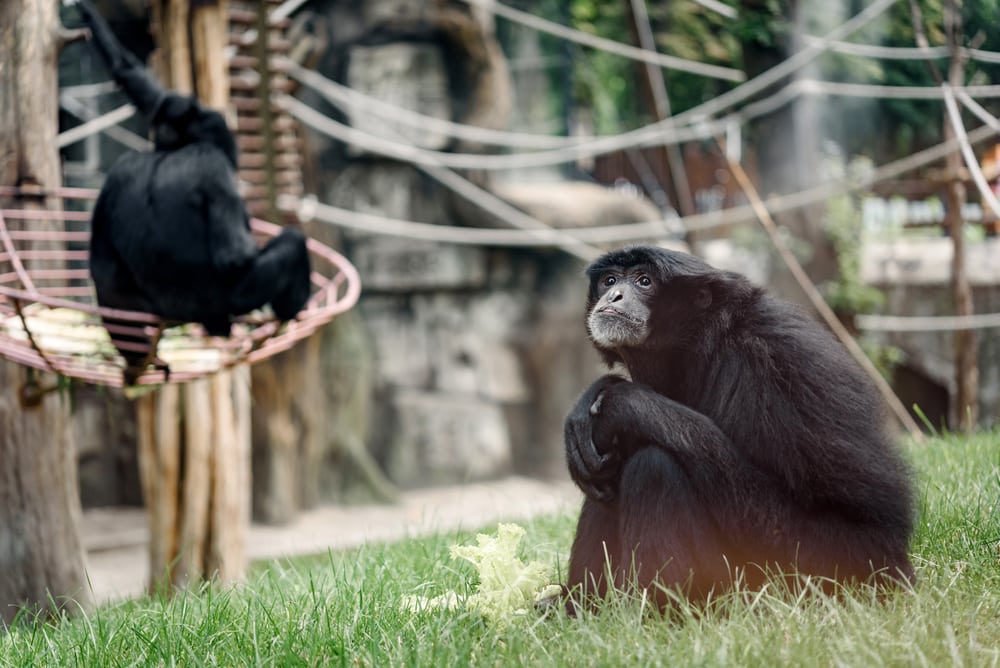
About 200,000 individuals still live in Sumatara. Siamangs are listed as “endangered” by the International Union of Conservation. Their populations have declined by 50% in the past 40 years alone.
You may also like: What is Poaching and Why is It Practiced?
Threats & Predators
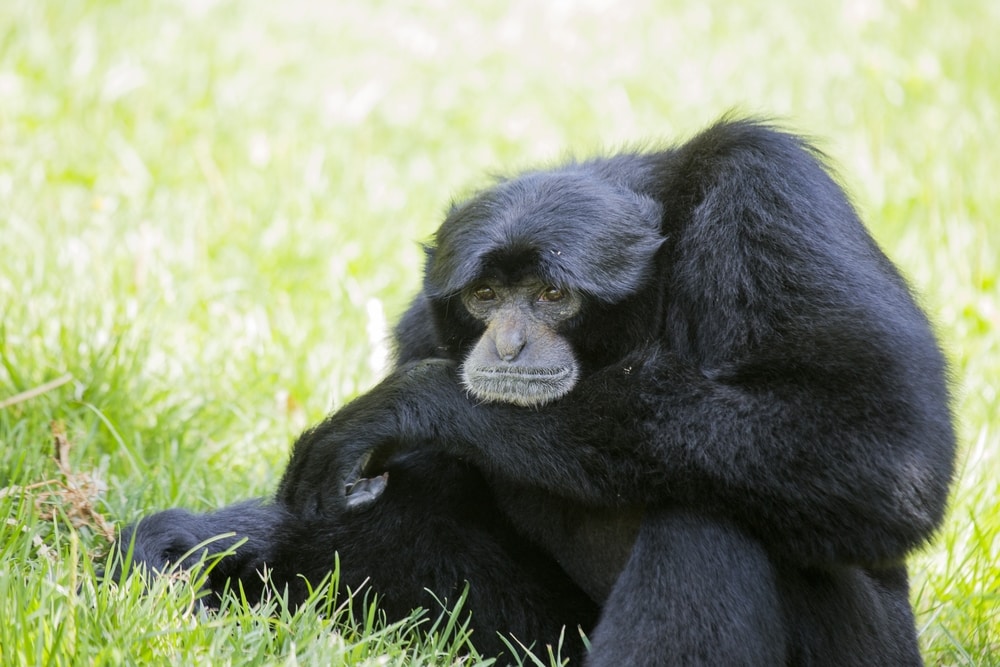
These apes’ main threat is habitat loss due to human development. Timber extraction across Indonesia and southeast Asia is occurring at unsustainable rates. Habitat degradation is also occurring due to agriculture, mostly of palm oil.
Their populations are also suffering because of illegal capture for pet trades. The adults are often killed so the infants can be taken and raised as pets.
This practice is illegal as siamangs are protected by law. But it’s not well-regulated and is a fairly common occurrence. In southeast Asia, siamang infants make very popular pets. The illegal pet trade is doing better than ever.
Predators of siamangs are not well-documented. Researchers believe that the young are likely at most risk from avian predators. Large snakes and carnivores may also be predators of both adults and their young.
You may also like: Nature’s 11 Loudest Voices: What Is The Loudest Animal In The World?
What Role Do They Play in the Environment?
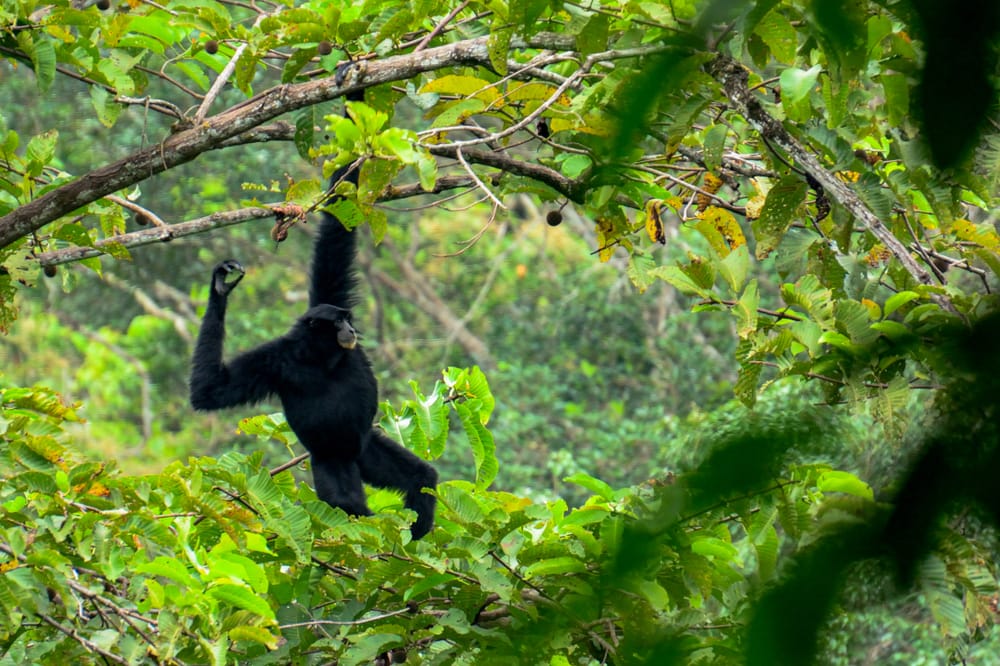
The diet of siamangs consists mostly of fruits. So, these apes are incredibly important for the distribution of various plant species. Siamangs eat over 160 different species of plants. So, if these apes were to die out, it would drastically affect the growth and distribution of many plants.
When they defecate, their feces contain a large amount of seeds. They can travel up to 1 mile (1.6km) in a day, so they are important for seed dispersal.
FAQ
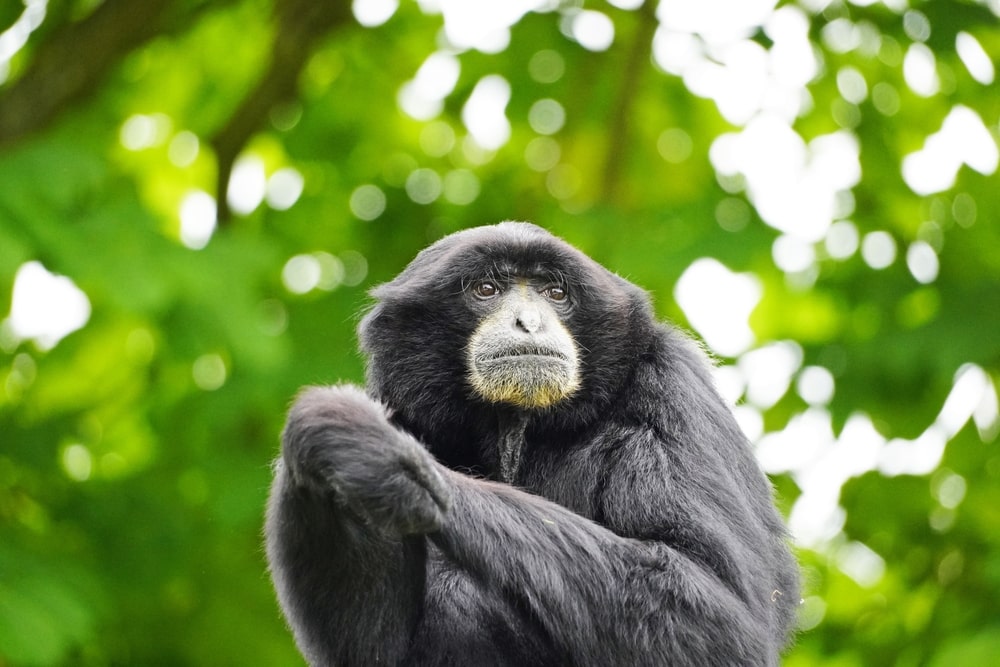
What is the difference between a gibbon and a siamang?
Siamangs are gibbons. So the true differences lie in which species of gibbon you’re looking at.
Siamangs are the largest species of gibbon in the world. Their size is their biggest difference and what sets them apart from other gibbons. This is largely because gibbons are small apes.
What is siamang in English?
It doesn’t seem that siamang has a meaning in English. The name is just described as “a black gibbon (Hylobates syndactylus) of Sumatra and the Malay Peninsula that is the largest of the gibbons.”
Why is it named siamang?
The scientific name, Symphalangus syndactylus, comes from the Greek words “sum” and “phalanx.” “Sum” means “together,” and “phalanx” means “finger.”
How do you say siamang?
You pronounce the word “siamang” pretty much how you would expect. It’s pronounced as “si-a-mang.”
How loud is a siamang?
The siamangs’ large throat sacs allow them to project their voices so that they’re very loud. Their voices are so loud, in fact, that they can carry as far as 2 miles (3.2km) across a densely forested area.
Are siamangs intelligent?
Siamangs, along with other gibbons, are intelligent primates. They can demonstrate problem-solving and higher-order thinking. They can learn how to trap, open, and eat food using simple tools.
Their complex vocalizations are thought to indicate a variety of emotions as well.









